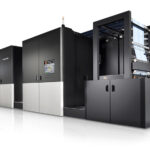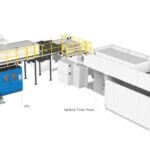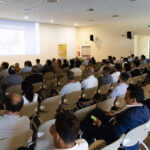Labeling is growing on the technological and market level, and in Italy the industry is in a good state of health. Trends and analyses from the recent Gipea Conference, with an excursus on the new features seen at Labelexpo and an interesting “lesson” on digital printing.
 A year ago, at the traditional conference organized by Gipea every end of the year to review the situation on the Italian selfadhesive label industry, the two economists who work at the sector trend Observatory facetiously set a serious question: «If your rich uncle from America wanted to buy an Italian concern, would he be advised to invest in a label maker?». On analysing the general data of the sector and the indicators on the state of health of the concerns involved in the study, the answer would without a doubt have been yes: the rich uncle would have made a good deal.But is this still the case? The same economists (Federico Visconti, recently nominated rector of LIUC, and Gianluca Cinti, Partners SpA) said yes at the last edition of the meeting (Milano, November 13 2015), that was directed by Alberto Quaglia and Italo Vailati (respectively president and secretary of Gipea). They reported encouraging trends and delved into the objectives, tools and investments of the label manufacturers, and were introduced by the interesting report on the European context given by Elisabetta Brambilla (Eurolabel, vice president Gipea) on the basis of a well pondered synthesis of the latest Finat market survey.
A year ago, at the traditional conference organized by Gipea every end of the year to review the situation on the Italian selfadhesive label industry, the two economists who work at the sector trend Observatory facetiously set a serious question: «If your rich uncle from America wanted to buy an Italian concern, would he be advised to invest in a label maker?». On analysing the general data of the sector and the indicators on the state of health of the concerns involved in the study, the answer would without a doubt have been yes: the rich uncle would have made a good deal.But is this still the case? The same economists (Federico Visconti, recently nominated rector of LIUC, and Gianluca Cinti, Partners SpA) said yes at the last edition of the meeting (Milano, November 13 2015), that was directed by Alberto Quaglia and Italo Vailati (respectively president and secretary of Gipea). They reported encouraging trends and delved into the objectives, tools and investments of the label manufacturers, and were introduced by the interesting report on the European context given by Elisabetta Brambilla (Eurolabel, vice president Gipea) on the basis of a well pondered synthesis of the latest Finat market survey.
Il quadro europeo
The European pictureThe figures of the European federation of label manufacturers, covering the period 2013-14 and provided by some seventy associated Finant members out of a total of 300, outline a sector showing growth, with better performance in the North (which in 2014 grew by more than 8% on 2013), in the UK and the East (+ 10.1%); an excellent profitability (from a minimum of 4.2 and a maximum of 12.2% in the East); labor costs which are increasing along with growth (but not everywhere: in Italy in 2014 they remained stable); and with a particularly strong growth in transport-logistics and beverage sectors.
The information on the technologies adopted testifies to the advance of digital printing, especially in the pharmaceutical sector and in sectors dominated by small job lots, but on this regard it should be stated, taking the turnover of a label maker as 10, the contribution of conventional printing stands at 9, while that of digital printing accounts for a modest one (by “conventional”, says Brambilla, one now almost almost means combined machines). It is not surprising therefore that the investment projects formulated in the period under examination – and hence implemented subsequent to the same period, in the first six months of 2015 – were more or less evenly divided between digital (31%) and conventional (33%) machines, plus auxiliary equipment, for projects of rationalization and saving (38%) as well as finishing systems (31%). With a clarification: in this survey in 54% of cases digital is referred to inkjet and in the remaining 46% to digital with toner, and other existing systems are not considered.
Another interesting piece of information extrapolated from the Finat survey regards the propensity of label makers to diversify their offer with new product lines. It can be seen in this regard that pouches are considered as a highly interesting outlet by 8% of respondents and “quite interesting” by 35% (12% are already actively involved in this segment), while sleeves are more popular, since more than 40% of survey respondents already make them, 20% consider them as highly interesting and 18% fairly interesting. They are followed by in-mould labeling (with 20% of label makers active in this field, 11% highly interested and 18% somewhat interested in getting involved); flexible packaging, practiced by 27% of the sample and only considered truly interesting by a further 16%. Ultimately, folding cartons are produced by a mere 8%, considered fairly interesting by 14% and highly interesting by a 5%, set against a 73% that declare themselves “not involved and not interested” in making the same.And the willingness to sell one’s company, whether for the reason for growing in size or for changing one’s line of business? Apparently, in the next five years we shouldn’t expect any earthquakes, but rather a few little telluric shocks: 70% of owners declare they would never cede their company, compared with a 10% quite ready to do so and a 20% uncertain (those certain they would do so stand at around 2%). As regards the principal threats to business development, they are in part seen to derive from the constraints and burdens imposed by legislation and rules of conformity (18% of respondents), but are mainly seen to be due to the vertical interaction of customers (10%), from low cost competition (40%) and consolidation-mergers between competitors (over 45%). Overall there is a general expectation of further growth also in the coming years.
Turnover and margins are growing
According to the latest Economic Observatory made on the basis of 2014 data provided by 98 companies with a total turnover of 662 million euros, in Italy labeling is doing okay, even if not as well as other European countries, which are doing even better (including Spain that, it should be stated, has an industrial structure similar to the Italian one), in 2014 Italian label manufacturers speeded up growth, with a production seen to be +4.1% (more than many user industries, the commentators state) that in the first nine months of 2015 rose further (+ 7.2%).
As well as turnover (also increased in actual terms) significant indicators such as gross operating surplus, pre tax results and the profitability of investments (that are back on the up) also show a positive trend.As for the financial situation in this sector too Italian concerns present a capitalization deficit; however their indebtedness is low and and they have a good repayment ability. The analysts tell us to watch out however, the figures for the debt rate do not include leasing, which in 2014 increased significantly, apparently because cheaper (or more accessible) than other forms of credit.Summing up: Why should our rich American Uncle want to buy an Italian label making concern? Because in 2014 more companies in this sector showed growth, and two digit growth at that, than saw their revenue drop (the best performances were registered in the small company segment, between 2.5 and 5 millions.
Success factors and investment choices
Success factors and investment choicesWhat does the market (brand and retail companies) demand from label makers? More quality and more service, in addition to price, of course… And because customers favour integrated purchasing processes, those who are able to offer a full range of products and services are at an advantage. We are speaking of the Italian domestic market, but exports are also growing and if currently in the field exports stand at around 13%, in mid-sized companies exports reach 18% and in the most lively cases exports are up to 40%, thus showing that “it can be done”.
Referring to the statements made by the operators but also to the studies made by the International labelling “guru” Mike Farley (guest speaker at the Gipea conference last May), Cinti closes his report mentioning the mix of factors and opportunities that influence the tendencies and the technology choices of label making concerns. One goes from the already mentioned growth of digital printing to diversification of production, the greater propensity to grow along external lines (via mergers and acquisitions) to the need to requalify and reorganize work. In this regard, the change requires new skills in many areas (management of sophisticated customers, design, communication, IT, web…), less rigid procedures and more flexibility, less hierarchy and more “internal marketing” (starting from the identification of the growth needs of the company organization and resources), a more “professional” management of resources also in SMEs and a greater presence in the delicate process of generational change.

















